Page 251 of 532
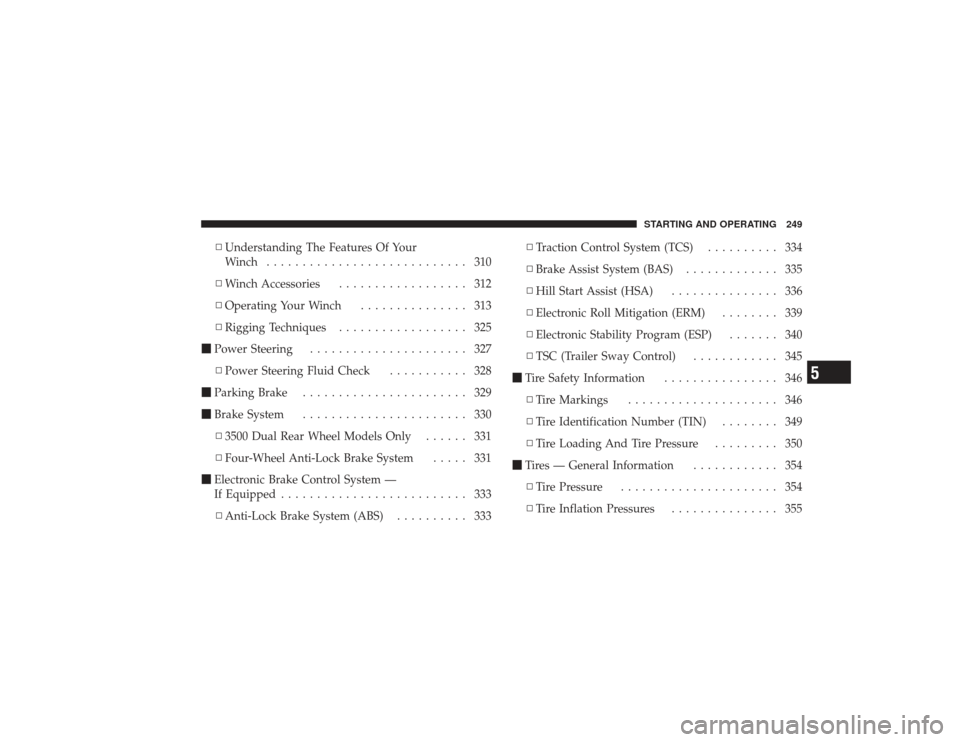
▫Understanding The Features Of Your
Winch ............................ 310
▫ Winch Accessories .................. 312
▫ Operating Your Winch ............... 313
▫ Rigging Techniques .................. 325
� Power Steering ...................... 327
▫ Power Steering Fluid Check ........... 328
� Parking Brake ....................... 329
� Brake System ....................... 330
▫ 3500 Dual Rear Wheel Models Only ...... 331
▫ Four-Wheel Anti-Lock Brake System ..... 331
� Electronic Brake Control System —
If Equipped .......................... 333
▫ Anti-Lock Brake System (ABS) .......... 333▫
Traction Control System (TCS) .......... 334
▫ Brake Assist System (BAS) ............. 335
▫ Hill Start Assist (HSA) ............... 336
▫ Electronic Roll Mitigation (ERM) ........ 339
▫ Electronic Stability Program (ESP) ....... 340
▫ TSC (Trailer Sway Control) ............ 345
� Tire Safety Information ................ 346
▫ Tire Markings ..................... 346
▫ Tire Identification Number (TIN) ........ 349
▫ Tire Loading And Tire Pressure ......... 350
� Tires — General Information ............ 354
▫ Tire Pressure ...................... 354
▫ Tire Inflation Pressures ............... 355
STARTING AND OPERATING 249
5
Page 252 of 532

▫Tire Pressures For High Speed Operation . . . 356
▫ Radial Ply Tires ..................... 357
▫ Tire Spinning ....................... 357
▫ Tread Wear Indicators ................. 358
▫ Life Of Tire ........................ 359
▫ Replacement Tires .................... 359
� Supplemental Tire Pressure Information —
If Equipped .......................... 360
� Tire Chains .......................... 361
� Snow Tires .......................... 363
� Tire Rotation Recommendations ........... 363
▫ Dual Rear Wheels .................... 365
� Tire Pressure Monitor System (TPMS) —
If Equipped .......................... 366 ▫
Tire Pressure Monitor System (TPMS) Tire
Light Load Inflation Switch Description –
If Equipped ........................ 369
▫
Tire Pressure Monitor System Components
. . 372
▫ General Information .................. 374
� Fuel Requirements ..................... 375
▫ Reformulated Gasoline ................ 375
▫ Gasoline/Oxygenate Blends ............. 376
▫ E-85 Usage In Non-Flex Fuel Vehicles ...... 376
▫ MMT In Gasoline .................... 377
▫ Materials Added To Fuel ............... 377
▫ Fuel System Cautions ................. 378
▫ Carbon Monoxide Warnings ............ 379
250 STARTING AND OPERATING
Page 253 of 532
�Adding Fuel ........................ 379
▫ Loose Fuel Filler Cap (Gas Cap) Message . . 381
� Vehicle Loading ..................... 381
▫ Certification Label .................. 381
� Trailer Towing ....................... 383
▫ Common Towing Definitions ........... 384
▫ Trailer Hitch Classification ............ 388
▫ Trailer Towing Weights (Maximum Trailer
Weight Ratings) ..................... 389
▫ Trailer And Tongue Weight ............ 389▫
Towing Requirements ................ 390
▫ Towing Tips ....................... 395
� Snowplow ......................... 396
� Recreational Towing
(Behind Motorhome, Etc.) ................ 397
▫ Recreational Towing – Two-Wheel Drive
Models ........................... 397
▫ Recreational Towing – Four-Wheel Drive
Models ........................... 397
� Equipment Identification Plate ........... 403
STARTING AND OPERATING 251
5
Page 257 of 532
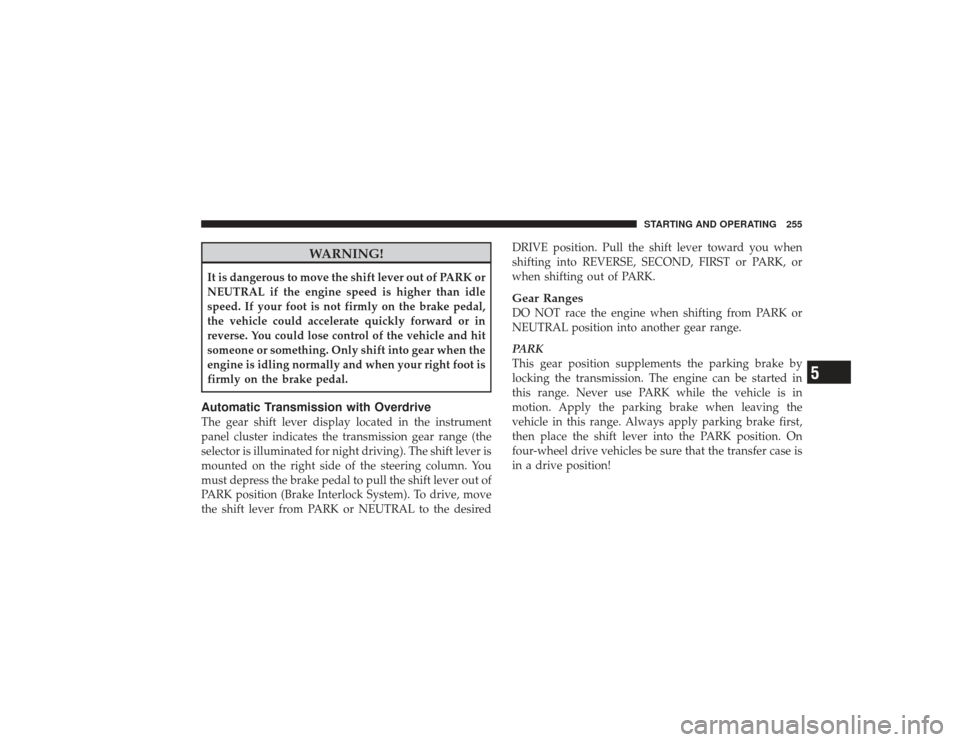
WARNING!
It is dangerous to move the shift lever out of PARK or
NEUTRAL if the engine speed is higher than idle
speed. If your foot is not firmly on the brake pedal,
the vehicle could accelerate quickly forward or in
reverse. You could lose control of the vehicle and hit
someone or something. Only shift into gear when the
engine is idling normally and when your right foot is
firmly on the brake pedal.Automatic Transmission with OverdriveThe gear shift lever display located in the instrument
panel cluster indicates the transmission gear range (the
selector is illuminated for night driving). The shift lever is
mounted on the right side of the steering column. You
must depress the brake pedal to pull the shift lever out of
PARK position (Brake Interlock System). To drive, move
the shift lever from PARK or NEUTRAL to the desiredDRIVE position. Pull the shift lever toward you when
shifting into REVERSE, SECOND, FIRST or PARK, or
when shifting out of PARK.
Gear RangesDO NOT race the engine when shifting from PARK or
NEUTRAL position into another gear range.
PARK
This gear position supplements the parking brake by
locking the transmission. The engine can be started in
this range. Never use PARK while the vehicle is in
motion. Apply the parking brake when leaving the
vehicle in this range. Always apply parking brake first,
then place the shift lever into the PARK position. On
four-wheel drive vehicles be sure that the transfer case is
in a drive position!
STARTING AND OPERATING 255
5
Page 262 of 532
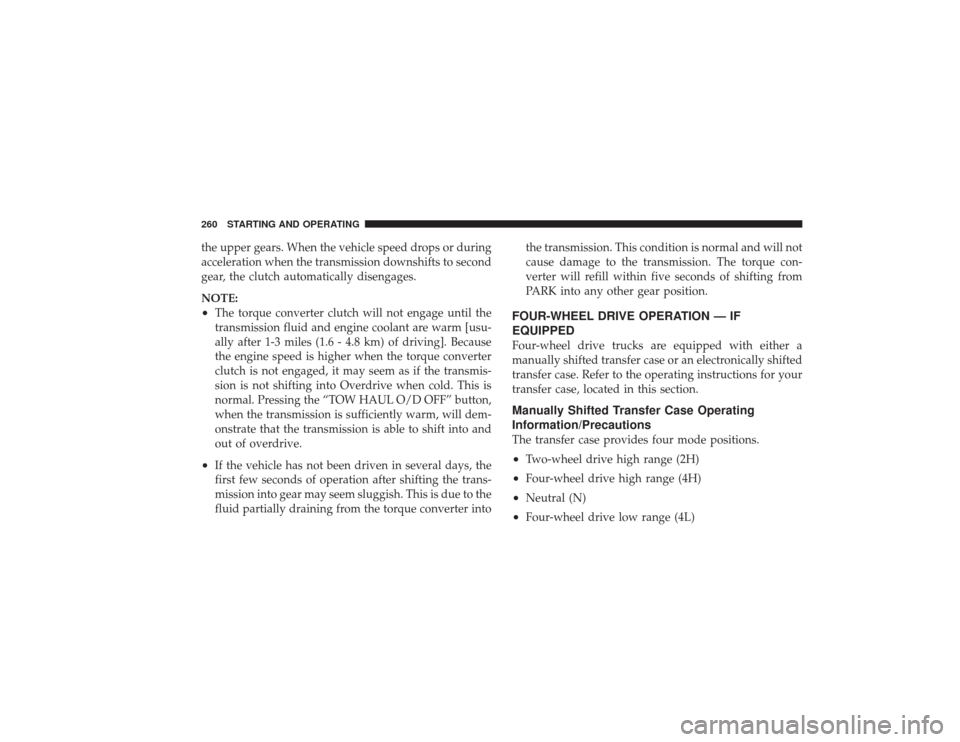
the upper gears. When the vehicle speed drops or during
acceleration when the transmission downshifts to second
gear, the clutch automatically disengages.
NOTE:•
The torque converter clutch will not engage until the
transmission fluid and engine coolant are warm [usu-
ally after 1-3 miles (1.6 - 4.8 km) of driving]. Because
the engine speed is higher when the torque converter
clutch is not engaged, it may seem as if the transmis-
sion is not shifting into Overdrive when cold. This is
normal. Pressing the “TOW HAUL O/D OFF” button,
when the transmission is sufficiently warm, will dem-
onstrate that the transmission is able to shift into and
out of overdrive.
•
If the vehicle has not been driven in several days, the
first few seconds of operation after shifting the trans-
mission into gear may seem sluggish. This is due to the
fluid partially draining from the torque converter intothe transmission. This condition is normal and will not
cause damage to the transmission. The torque con-
verter will refill within five seconds of shifting from
PARK into any other gear position.
FOUR-WHEEL DRIVE OPERATION — IF
EQUIPPEDFour-wheel drive trucks are equipped with either a
manually shifted transfer case or an electronically shifted
transfer case. Refer to the operating instructions for your
transfer case, located in this section.Manually Shifted Transfer Case Operating
Information/PrecautionsThe transfer case provides four mode positions.•
Two-wheel drive high range (2H)
•
Four-wheel drive high range (4H)
•
Neutral (N)
•
Four-wheel drive low range (4L)
260 STARTING AND OPERATING
Page 263 of 532
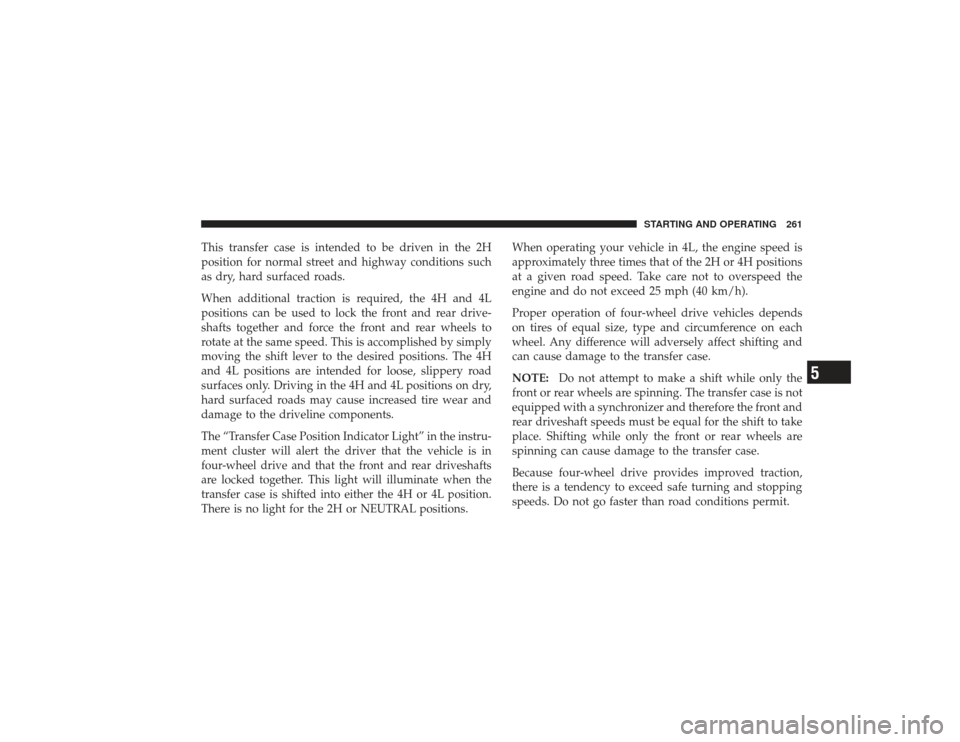
This transfer case is intended to be driven in the 2H
position for normal street and highway conditions such
as dry, hard surfaced roads.
When additional traction is required, the 4H and 4L
positions can be used to lock the front and rear drive-
shafts together and force the front and rear wheels to
rotate at the same speed. This is accomplished by simply
moving the shift lever to the desired positions. The 4H
and 4L positions are intended for loose, slippery road
surfaces only. Driving in the 4H and 4L positions on dry,
hard surfaced roads may cause increased tire wear and
damage to the driveline components.The “Transfer Case Position Indicator Light” in the instru-
ment cluster will alert the driver that the vehicle is in
four-wheel drive and that the front and rear driveshafts
are locked together. This light will illuminate when the
transfer case is shifted into either the 4H or 4L position.
There is no light for the 2H or NEUTRAL positions.
When operating your vehicle in 4L, the engine speed is
approximately three times that of the 2H or 4H positions
at a given road speed. Take care not to overspeed the
engine and do not exceed 25 mph (40 km/h).
Proper operation of four-wheel drive vehicles depends
on tires of equal size, type and circumference on each
wheel. Any difference will adversely affect shifting and
can cause damage to the transfer case.
NOTE:Do not attempt to make a shift while only the
front or rear wheels are spinning. The transfer case is not
equipped with a synchronizer and therefore the front and
rear driveshaft speeds must be equal for the shift to take
place. Shifting while only the front or rear wheels are
spinning can cause damage to the transfer case.
Because four-wheel drive provides improved traction,
there is a tendency to exceed safe turning and stopping
speeds. Do not go faster than road conditions permit.
STARTING AND OPERATING 261
5
Page 264 of 532
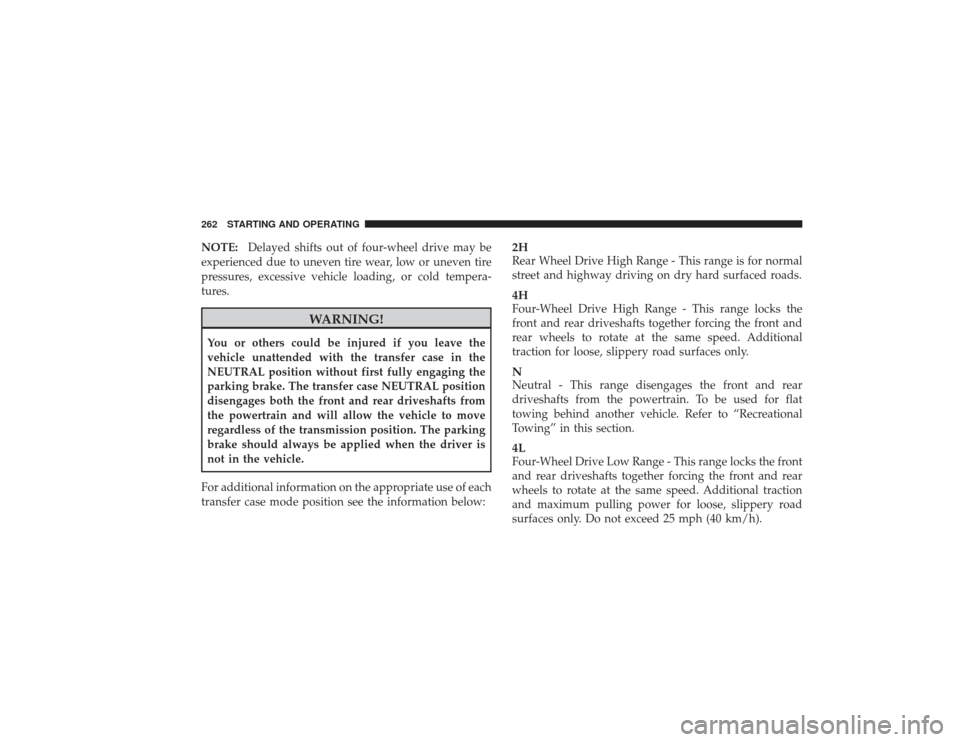
NOTE:Delayed shifts out of four-wheel drive may be
experienced due to uneven tire wear, low or uneven tire
pressures, excessive vehicle loading, or cold tempera-
tures.
WARNING!
You or others could be injured if you leave the
vehicle unattended with the transfer case in the
NEUTRAL position without first fully engaging the
parking brake. The transfer case NEUTRAL position
disengages both the front and rear driveshafts from
the powertrain and will allow the vehicle to move
regardless of the transmission position. The parking
brake should always be applied when the driver is
not in the vehicle.
For additional information on the appropriate use of each
transfer case mode position see the information below:
2HRear Wheel Drive High Range - This range is for normal
street and highway driving on dry hard surfaced roads.4HFour-Wheel Drive High Range - This range locks the
front and rear driveshafts together forcing the front and
rear wheels to rotate at the same speed. Additional
traction for loose, slippery road surfaces only.NNeutral - This range disengages the front and rear
driveshafts from the powertrain. To be used for flat
towing behind another vehicle. Refer to “Recreational
Towing” in this section.4LFour-Wheel Drive Low Range - This range locks the front
and rear driveshafts together forcing the front and rear
wheels to rotate at the same speed. Additional traction
and maximum pulling power for loose, slippery road
surfaces only. Do not exceed 25 mph (40 km/h).
262 STARTING AND OPERATING
Page 266 of 532
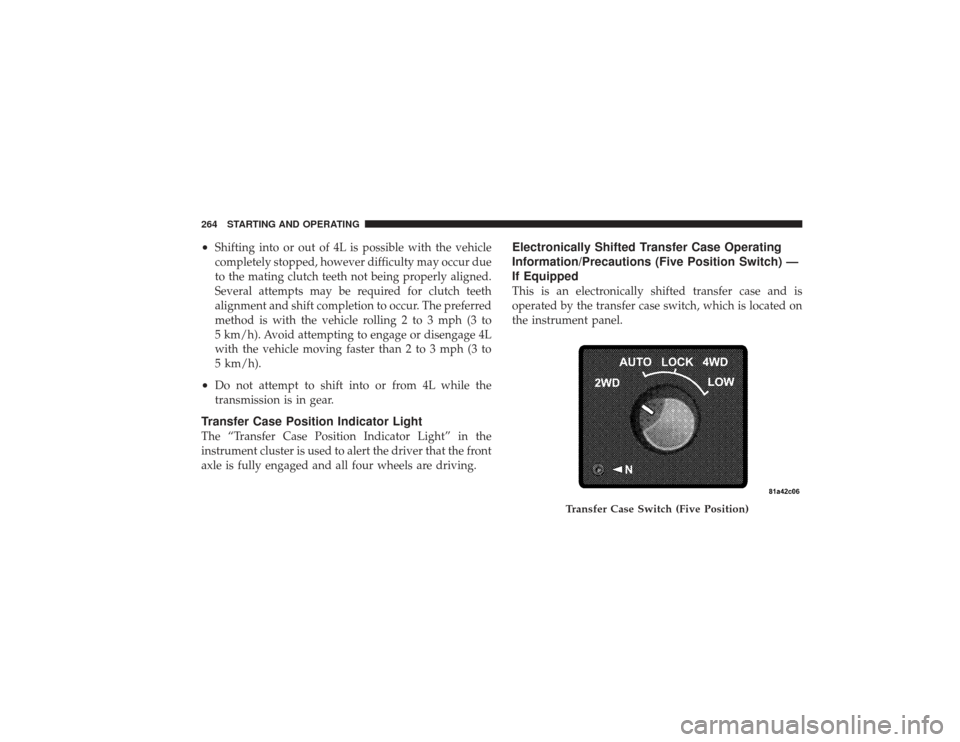
•
Shifting into or out of 4L is possible with the vehicle
completely stopped, however difficulty may occur due
to the mating clutch teeth not being properly aligned.
Several attempts may be required for clutch teeth
alignment and shift completion to occur. The preferred
method is with the vehicle rolling 2 to 3 mph (3 to
5 km/h). Avoid attempting to engage or disengage 4L
with the vehicle moving faster than 2 to 3 mph (3 to
5 km/h).
•
Do not attempt to shift into or from 4L while the
transmission is in gear.
Transfer Case Position Indicator LightThe “Transfer Case Position Indicator Light” in the
instrument cluster is used to alert the driver that the front
axle is fully engaged and all four wheels are driving.
Electronically Shifted Transfer Case Operating
Information/Precautions (Five Position Switch) —
If EquippedThis is an electronically shifted transfer case and is
operated by the transfer case switch, which is located on
the instrument panel.
Transfer Case Switch (Five Position)
264 STARTING AND OPERATING